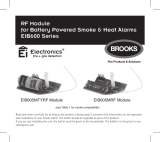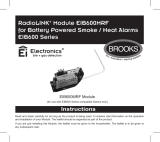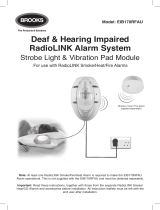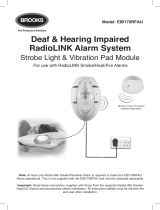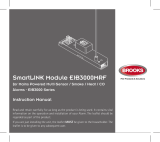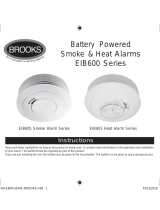Page is loading ...

Instructions
Read and retain carefully for as long as the product is being used. It contains vital information on the operation
and installation of your Module. The leaflet should be regarded as part of the product.
If you are just installing this Module, the leaftet must be given to the householder. The leaflet is to be given to
any subsequent user.
EIB100MRF Module
(for use with eSeries Alarms only)
RadioLINK
+
Module EIB100MRF
for Mains Powered Smoke / Heat Alarms
EIB160e / EIB2110e Series


2
Introduction ................................................................................
Installation and House Coding ...................................................
Additional Features ....................................................................
Indicator Summary .....................................................................
System Examples .......................................................................
Testing the system .....................................................................
Interconnected Carbon Monoxide Alarms and Smoke Alarms ...
RadioLINK
+
Troubleshooting ......................................................
Technical Specifications .............................................................
Guarantee ..................................................................................
Limitations of Radio Communications ........................................
Table of Contents
3
4
10
11
12
15
16
17
18
19
19
page

3
The EIB100MRF RadioLINK
+
Module is the next generation RF module designed
to fit in the EIB160e and EIB2110e series, Easi-fit mains powered Alarms. The
EIB100MRF RadioLINK
+
Module effectively replaces the EIB168RF RadioLINK
Base.
The primary function of the EIB100MRF is to interconnect all Brooks Alarms in a
system by the means of an RF signal i.e. when one Alarm senses a fire event,
the EIB100MRF module attached to that Alarm will transmit an RF signal that will
activate the sounders in all other Alarms in the system.
The EIB100MRF module is plugged into the rear of the base of an EIB160e or
EIB2110e series Alarm. RF communication through this module eliminates the
need to install long interconnect wires between all the Alarms on different floors
in different rooms. The EIB100MRF is powered from the Alarm it is connected to.
The module also has “multiple repeater” transmission – this provides multiple signal
paths for a robust RF ‘mesh’ system and can also increase the RF range.
Introduction

N.B Disconnect Mains Before Alarm Head Removal
After disconnecting the mains power supply, it is now safe to remove the Alarm from
its base. Using a screwdriver, insert into the removal slot on the side of the Alarm.
Push the lower half of the Alarm away from the screwdriver, in the direction of the
arrow on the cover (see Figure 1 below).
CAUTION: The existing hard-wired interconnection may need to be disconnected
at this point by disconnecting the interconnect (black) wire from the terminal block
(refer to the Installation section in the Alarm instruction manual). If a hard-wired
connection and an RF connection exist between the SAME two Alarms, a
continuous alarm loop signal will occur.
4
Installation and House Coding
Figure 1

Fitting the EIB100MRF Module
To fit the EIB100MRF Module, first hold the flexible antenna and guide it into its
designated hole in the rear of the unit until about 2/3 of its length is inserted (Fig.
2a). Then, hold the module housing (Fig. 2b) & plug it into the Alarm, being careful
to align the pins and keeping them perpendicular to the base as the module is
inserted (Fig. 2c). Ensure the module is fully home, by checking that it is flush with
the surrounding Alarm housing (Fig. 2d).
5
Pin
Alignment
Pin
Alignment
Pin
Alignment
Figure 2a Figure 2b Figure 2c

6
House Coding the Unit
Ensure that the Alarm is re-connected to
the base correctly by checking for the
green LED on the unit. Power supply to the
EIB100MRF will be confirmed by an initial
flash of the red, blue and green LED on the
side of the unit (see Fig 3).
Using a screwdriver, press and hold the
House Code button on the side of the unit
until the blue light illuminates (see Fig 4).
Immediately release the button, the Blue
light will flash rapidly and then stop.
The flashing will repeat every 5 seconds
thereafter. Repeat this procedure for
all Alarms in the system and any RF
accessories such as the EIB450 Alarm
Controller.
Check to ensure all RF devices have been successfully House Coded. This can
be done by counting the number of blue flashes on each RF Module. The number
of flashes should correspond to the number of RF devices in the system. (i.e. 4
flashes if there are 4 devices in the system).
N.B. We recommend, for ease of installation and RF communication, that up
to 12 RF devices can be installed in any one RF coded system. Please contact
us for further advise if additional RF devices are required.
If all devices have House Coded you can exit this mode by pressing the House
Code button on one of the devices. Keep the button pressed until the blue light
Pin
Alignment
Figure 2d

7
Figure 4
blue, red & green LED
Figure 3

comes on solid and then release.
The unit will now send a signal to all the other devices in the system to exit House
Code. Alternatively, the devices will automatically exit the House Code mode after
30 minutes. To ensure that all units are House Coded, press the test button on any
device. After a few seconds all units should now sound their alarm. Caution: Do
not House Code another group (e.g. adjacent apartment) until the current House
Code has been completed.
Factory Reset
Sometimes in order to resolve an RF communication issue it may be necessary
to reset (factory reset) and House Code the system again. To do so, press and
hold the House Code button until you see a flashing blue light on the Alarm cover
(approx. 7 seconds), release immediately. Repeat this procedure on all units.
Removing the EIB100MRF Module
If it is necessary to remove or replace
an RF Module already fitted to an Alarm,
it can be taken out by firstly using your
index finger to lift it by 5 to 6mm to
release the connection pins (Fig. 5a),
repeat this process on the opposite end
to release the antenna (Fig. 5b), after
which the module can be fully removed
from the Alarm by lifting it away while
keeping the pins perpendicular to the
Alarm (Fig. 5c).
Pin
Alignment
Figure 5a
8

9
Pin
Alignment
Figure 5b
Pin
Alignment
Figure 5c

The EIB100MRF RadioLINK
+
Module provides additional features not available
with Brooks RadioLINK products. The following features will only work with
RadioLINK
+
devices.
1. Remote House Coding (required if you want to add an Alarm to an installed system)
2. Data Extraction
*Note these functions will not be available unless you have completed House Code Entry.
1. Remote House Coding
If it is necessary to extend an RF system or you find that you want to add an extra
Alarm to a system you can now do so quite simply via the ‘Remote House Coding’
feature. Firstly using a screwdriver, press and hold the House Code button of one of
the previously installed Alarms until you see all colours flashing (red, blue, green).
Immediately release the button. This Alarm will now send an RF message to all the
previously installed (compatible) devices to re-enter House Code mode. Similarly,
install and put the new Alarm you wish to add to the system into House Code mode
(see “Installation and House Coding” section). As before, allow sufficient time so
that all Alarms are now house coded correctly (this can be confirmed by counting
the number of flashes on each Alarm). You can then exit House Code mode
manually or let it exit automatically after 30 minutes. (N.B. for this feature to work
all devices in the system must be RadioLINK+).
10
Additional Features

2. Data Extraction
The EIB100MRF RadioLINK+ Module is equipped with a feature that allows for
the extraction of information from a Brooks Compatible Alarm, using a Brooks
download device. Once the system has been set up, information can be accessed
securely from within or outside a property if access is an issue The event log can
contain very useful information about any recorded events in the history of the
Alarm such as: Fire Events, Alarm Head removals, Button Tests, and so on.
Event logs can be retrieved as many times as necessary.
11
%OXH/('%XWWRQ$FWLRQ 5HG/(' *UHHQ/('6RXQGHU
+RXVH&RGH(QWHU3UHVV5HOHDVHRQ6ROLG%OXH
3UHVV5HOHDVHRQ)ODVKLQJ%OXH
)ODVKHVEULHIO\VWRSV
,Q+RXVHFRGH
)DFWRU\5HVHW
0RGH(QWHU([LW
2II 2II 2II
IODVKSHUXQLWHYHU\6HF
2II
6HHಫ,QVWDOODWLRQDQG+RXVH&RGLQJಬVHFWLRQIRUIXUWKHUGHWDLOV
2II 2II
5DSLGIODVKLQJIROORZHGE\VLQJOHIODVK
2II 2II 2II
3UHVV5HOHDVHRQ6ROLG%OXH
+RXVHFRGH([LW
6HFIODVK
2II 2II 2II
5HPRWH+RXVH&RGLQJ 3UHVV5HOHDVHRQ0XOWL&RORXU)ODVKLQJ5DSLGIODVKLQJIROORZHGE\6HFIODVK
2II 2II 2II
3RZHU8S
%OXH/(' 5HG/(' *UHHQ/('6RXQGHU
$ODUP
+HDG5HPRYDO
)XOO6RXQG
1RUPDO2SHUDWLRQ
6WDQGE\
IODVKIODVK
6HFIODVKIROORZHGE\IODVKHYHU\6HF
6HFIODVKHYHU\PLQVIRUKUV
2II 2II
2II
2II
IODVK
2II 2II
2II
2II
2II
2II
(,%05),QGLFDWRU6XPPDU\

System Examples
12
RadioLINK
+
Smoke Alarm
RadioLINK
+
Heat Alarm
RadioLINK
+
Smoke Alarm
RadioLINK
+
Heat Alarm
RadioLINK
+
Smoke Alarm
RF Tool
Data Extraction
RadioLINK
+
System
Hardwired
Smoke Alarm
Hardwired
Heat Alarm
Hardwired
Smoke Alarm
RadioLINK
+
Smoke Alarm
RadioLINK
+
EIB2110e
MultiSensor Alarm *
RF Tool
Data Extraction
RadioLINK
+
& Hardwired Hybrid System
RF System
(RadioLINK & RadioLINK
+
)
RadioLINK
Smoke Alarm
RadioLINK
Heat Alarm
RadioLINK
Smoke Alarm
RadioLINK
Smoke Alarm
Note: Remote House Coding / Monitoring / Data Extraction only available on RadioLINK
+
Alarms
RadioLINK
+
Smoke Alarm
RadioLINK
+
Heat Alarm
RF Tool
Data Extraction
* N.B. In Hybrid systems we recommend that the link Alarm be an EIB2110e MultiSensor Alarm

13
RadioLINK
+
Smoke Alarm
RadioLINK
+
Heat Alarm
RadioLINK
+
Smoke Alarm
RadioLINK
+
Heat Alarm
RadioLINK
+
Smoke Alarm
RF Tool
Data Extraction
RadioLINK
+
System
Hardwired
Smoke Alarm
Hardwired
Heat Alarm
Hardwired
Smoke Alarm
RadioLINK
+
Smoke Alarm
RadioLINK
+
EIB2110e
MultiSensor Alarm *
RF Tool
Data Extraction
RadioLINK
+
& Hardwired Hybrid System
RF System (RadioLINK & RadioLINK
+
)
RadioLINK
Smoke Alarm
RadioLINK
Heat Alarm
RadioLINK
Smoke Alarm
RadioLINK
Smoke Alarm
Note: Remote House Coding / Monitoring / Data Extraction only available on RadioLINK
+
Alarms
RadioLINK
+
Smoke Alarm
RadioLINK
+
Heat Alarm
RF Tool
Data Extraction
* N.B. In Hybrid systems we recommend that the link Alarm be an EIB2110e MultiSensor Alarm

14
RadioLINK
+
Smoke Alarm
RadioLINK
+
Heat Alarm
RadioLINK
+
Smoke Alarm
RadioLINK
+
Heat Alarm
RadioLINK
+
Smoke Alarm
RF Tool
Data Extraction
RadioLINK
+
System
Hardwired
Smoke Alarm
Hardwired
Heat Alarm
Hardwired
Smoke Alarm
RadioLINK
+
Smoke Alarm
RadioLINK
+
EIB2110e
MultiSensor Alarm *
RF Tool
Data Extraction
RadioLINK
+
& Hardwired Hybrid System
RF System (RadioLINK & RadioLINK
+
)
RadioLINK
Smoke Alarm
RadioLINK
Heat Alarm
RadioLINK
Smoke Alarm
RadioLINK
Smoke Alarm
Note: Remote House Coding / Monitoring / Data Extraction only available on RadioLINK
+
Alarms
RadioLINK
+
Smoke Alarm
RadioLINK
+
Heat Alarm
RF Tool
Data Extraction
* N.B. In Hybrid systems we recommend that the link Alarm be an EIB2110e MultiSensor Alarm

Check that the green light is on continuously to
indicate that mains power is present and that the
red light flashes every 40 seconds.
Frequent testing of the system is a requirement to
ensure its continued and safe operation. Guidelines
and best practices for testing are as follows:
1. After the system is installed.
2. Regularly (monthly testing is recommended).
3. After prolonged absence from the dwelling (e.g.
after holiday period).
4. After repair or servicing of any of the systems
elements or household electrical works.
5. After renovations to the house.
To test an individual Alarm press and hold the test
button until the horn sounds and the red light flashes.
This will ensure that the sensor, electronics and sounder are working.
To test the RadioLINK
+
system, press and hold the test button on one of the Alarms.
The blue LED from the EIB100MRF will illuminate for approximately 3.5 seconds.
Continue to hold the test button until all the Alarms in the system are sounding. This
will take between 20 to 45 seconds depending on the number of Alarms and their
locations in the system, e.g. a system with 12 Alarms may take up to 45 seconds for
them all to sound. Release the test button when the test is completed.
15
Testing the System

The local Alarm will stop sounding but you will hear the other Alarms still sounding
in the distance.
End of Life (EOL) Check
Check the ‘replace by date’ label on all EIB100MRF modules and attached Alarms.
If the date has been exceeded then the device should be replaced.
Identifying source of Alarm
Brooks Carbon Monoxide Alarms and Smoke Alarms can be interconnected via
RadioLINK or RadioLINK+ so that one device sensing danger will cause all the other
units to sound, enabling the alarm to be heard throughout the residence.
When a system alarms, check to see which unit has its red light flashing rapidly - this
it the source of the alarm.
If it is a Carbon Monoxide Alarm, ventilate the residence and follow the instructions
in the Carbon Monoxide Alarm manual.
If it is a Smoke Alarm, evacuate the residence and follow the instructions in the
Smoke Alarm manual.
For added convenience we recommend that an EIB450 Alarm Controller is used
with these systems.
When there is an alarm, an icon on the EIB450 Alarm Controller shows if it is a CO
or Fire incident.
Pressing the button with the units in alarm Locates the source of the alarm, as it
silences all the units apart from the unit sensing danger.
16
Interconnected Carbon Monoxide
Alarms and Smoke Alarms

(In normal standby mode the EIB450 Alarm Controller allows you to Test all the units
remotely without having to press the test button - ideal for units on high ceilings).
It is important that all Alarms in your system communicate with each other. The number
of walls, ceilings and metal objects in the signal path will reduce the strength of the
RadioLINK
+
signals between the Alarms. Accordingly, one or more Smoke/Heat/CO
Alarms may have difficulties in communicating to all the other Alarms in the system.
If, when checking the RadioLINK
+
interconnection, some of the Alarms do not
respond to the button test, then you will need to either:
(i) Position another RadioLINK
+
Alarm to act as a ‘repeater’ between the Alarms
which are not communicating and so shorten the path and/or by-pass an obstacle
which is blocking the signal. When the new Alarm is fitted, House Code all Alarms
again, as described above.
(ii) rotate / re-locate the Alarms (e.g. move them away from metal surfaces or wiring).
After making these changes to the RF signal path, the RadioLINK
+
signals may still
not be reaching all the Alarms in your system, even though they have already been
House Coded successfully. (see Section on “Limitations of Radio Communications”).
It is important to check that all Alarms are communicating in their final installed
positions. If Alarms are rotated, have had their antennas extended and/or re-sited,
we would recommend that all the Alarms are returned to the factory settings and
then House Coded again in their final positions (see above). The RadioLINK
+
interconnection should then be checked again by button testing all units.
17
RadioLINK
+
Troubleshooting

(Note: The RadioLINK
+
module can be returned to the originally factory settings by
pressing and holding the House Code switch until the blue light turns on solidly and
then flashes rapidly. This will take about 7 seconds. This clears the House Codes
that have been learnt).
Supply Voltage: 9V from attached Alarm
RF Range: A minimum of 100 metres in free space
RF Visual Indicator: Blue light flashes continuously for 0.5 to 3.5 seconds while
transmitting RF signal
RF Frequency: 926MHz (1% duty cycle)
Dimensions: 80mm length x 19mm depth x 16mm height
Temperature Range: 0° to 40°C
Humidity Range: 15% to 95% Relative Humidity
Interconnect: Up to 12 RadioLINK
+
or RadioLINK modules
Optional Accessories: EIB407RF Manual Call Point, EIB428RF Relay Module,
EIB450 RadioLINK Alarm Controller
Approvals: ACMA compliance to AS/NZS 4268:2012
EMC performance to EN 301 489-1 in accordance
with EN 301 489-3
18
Technical Specifications

Brooks guarantees this RF RadioLINK
+
Module for five years from date of purchase
against any defects that are due to faulty materials or workmanship. This guarantee
only applies to normal conditions of use and service, and does not include damage
resulting from accident, neglect, misuse, unauthorised dismantling, or contamination
howsoever caused. This guarantee excludes incidental and consequential damage.
If this RF RadioLINK
+
Module should become defective within the guarantee period,
it must be returned to Brooks, with proof of purchase, carefully packaged, with the
problem clearly stated. We shall at our discretion repair or replace the faulty unit.
Do not interfere with the Alarm or attempt to tamper with it. This will invalidate the
guarantee, but more importantly may expose the user to shock or fire hazards.
This guarantee is in addition to your statutory rights as a consumer.
Brooks radio communication systems are very reliable and are tested to high
standards. However, due to their low transmitting power and limited range (required
by regulatory bodies) there are some limitations to be considered:
(i) Receivers may be blocked by radio signals occurring on or near their operating
frequencies, regardless of the House Coding.
(ii) Alarms with RadioLINK
+
modules should be tested regularly, at least weekly.
19
Limitations of Radio
Communications
Guarantee
/

